Wine Taste in Beroun
Czech Republic!
"June 2002"
by
Marilyn King
Copyright © 2002—All rights reserved worldwide.
No part of this report may be reproduced without prior written
consent.
Na zdravi! (Cheers!)
Beroun, Czech Republic...
Verdant green hills and vales. Blossoming meadows. Beautiful breeze. Charming villages. A
castle looms in the distance. The landscape glistens. Sunshine!—after two days of continuous
rain.
Crossing the Vltava we leave the city behind us. We drive towards Plzen (Pilsen) along E50
to Beroun—a small town 30 minutes southwest of Prague. Enjoying the countryside, I look
forward to this wine-tasting experience! Spanish wines from Miguel Torres—"Winemaker of
the Year, Spain 2002."
Pilsen Gate—Welcome to
Beroun...
Photo by M. King
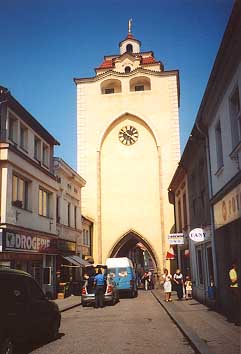
Beroun is located on the basin where the Berounka and Litavka rivers meet. It was settled in
ancient times. The Berounka connects Prague and Pilsen and was of utmost importance in
founding the original settlements.
The first written mention of Beroun was in 1088. In June 1265 King Premysl issued a
document confirming Beroun's existence. The name derived from Italian "Verona"—was later
changed to Beroun in the Czech language.
Many guild crafts developed in Beroun—pottery, milling, beer brewing, ginger-bread making,
metal manufacturing, and textiles.
In 1421, Beroun was captured by Hussite armies and became a Hussite town. In the
16th and 17th Centuries, Beroun was annihilated by plagues. Fire
and flood nearly destroyed Beroun several times.
The town fortification was constructed at the turn of the 13th–14th
Centuries. The thick stone walls were reinforced by 37 bastions, with a castle moat along the
walls. There was a lower moat wall inside.
Today, parts of the wall, 20 bastions in a partly preserved state, and two gates survive.
Pilsen Gate—Walk on
through...
Photo by M.
King 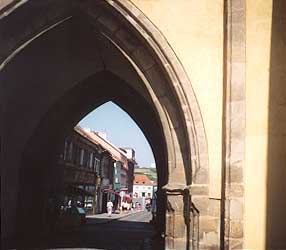
Beroun side street—
Look to your left...
Photo by M.
King 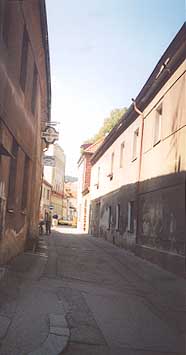
Enter Beroun through the Pilsen Gate, the original Gothic Tower leading to the moat.
The passage is arched by barrel vaulting and pointed gates. During a fire in 1735, the upper
part of the gate was destroyed—then rebuilt in Baroque style. Today, there is a room of the
original armory inside this tower. There is a gallery on the top floor.
Beroun Side Street—
Walk
to your right and look back...
Photo by M.
King
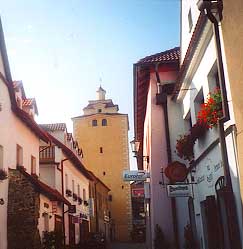
Beroun Main Street—
Walk towards Prague Gate!
Photo by M. King
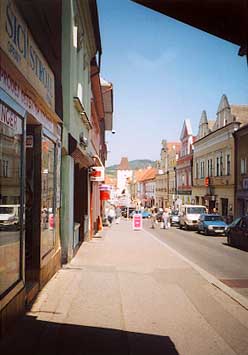
Beroun Centrum—Keep on
walking toward Prague Gate...
Photo by M. King
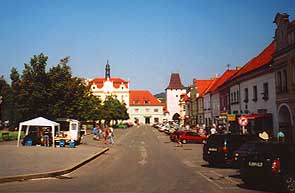
The Beroun square consists of shops and restaurants housed in historic
buildings. St. James Deanery Church, a Town Hall where weddings take place on
Saturdays—as well as a lovely park area. On Saturday mornings, there is an open air market
that lasts until 12noon.
The Town Hall was originally two burghers houses, later rebuilt in Renaissance style and then
Baroque style. The present building exists since the beginning of the 20th
Century.
Beroun Centrum!—
Lovely Park, Colorful Architecture!
Photo by M. King
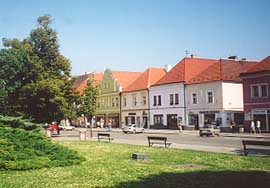
Beroun Centrum!—
Looking toward Town Hall...
Photo by M.
King
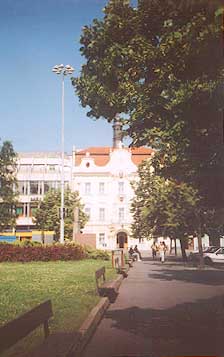
St. James Deanery Church—
Beroun's history...
Photo by M. King
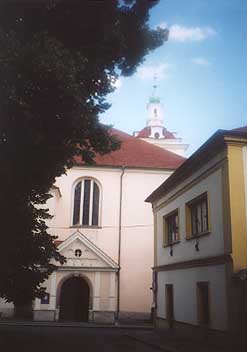
St. James Deanery Church was built in the 13th Century, at the same time as the
town. In the 14th Century, the tower was annexed. It was rebuilt later in
Baroque style, and then changed several times.
Prague Gate—You made
it!
Photo by M.
King
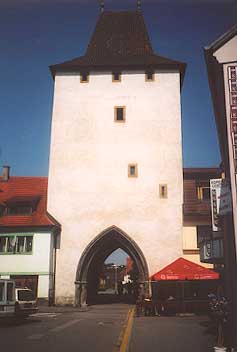
Exit Beroun through the Prague Gate. The passage is irregularly barrel vaulted,
closed by two pointed gates. A spiral staircase connects two large vaulted rooms inside the
building. Built at the beginning of the 14th Century, this is Beroun's oldest
structure preserved nearly perfectly in its original medieval Gothic form. The Prague Gate
exit leads you to the Berounka River.
Past the Prague Gate—
River scene...
Photo by M.
King
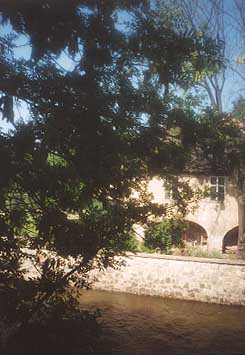
Past the Prague
Gate—
Nature by the River...
Photo by M.
King
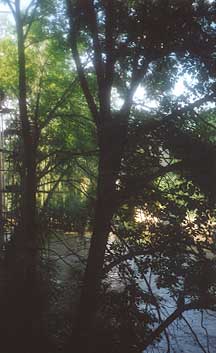
U Hradeb Restaurace—Lovely
to behold...
Photo by M.
King
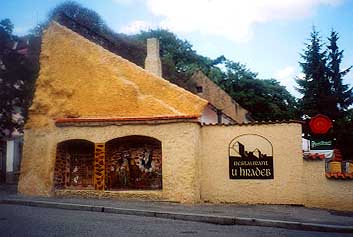
The U Hradeb restaurant built into an original town wall is lovely to look at. Charm both
inside and out. Unfortunately, neither food nor service matches the ambiance. We have
found excellent restaurants in Prague—as well as other Czech towns that we have visited. We
are still looking for a fine dining experience in Beroun.
Wine Tasting—Nine–Twelve
Wines will be tasted...
Photo by M.
King
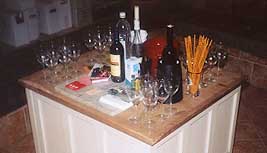
Wine is
Fine
Fine wine is one of my passions—my dinner is not complete without my glass of good wine. I
delight in a glass of white wine—very cold—with my salad. My glass of red wine enhances the
flavors of good cheese and bread.
As a child, I watched my father enjoy his daily glass in the evening. Daddy would always let
me have a little taste. Many years later, while living in California, I discovered I could
wine–taste all along Interstate–5, northbound...and...southbound! My appreciation of fine
wine deepened.
I discovered an even greater variety of superb wines when I journeyed throughout Europe and
South America. In restaurants...in vineyards.
Wine is very much part of everyday life in the Czech Republic—excellent in
quality...and inexpensive. Vinotekas are everywhere. You can taste and
enjoy!! Courses are offered in wine-tasting! I enrolled and learned more.
Let me share with you my love of fine wine. Taste and enjoy the wonderful wines of
Spain!!
Miguel Torres Wine
Tasting—
The Torres winery dates back to 1870, when Jaime Torres established the family winemaking
operation in Vilafranca del Penedès (Catalonia, Spain) 5 km south of Barcelona. The
Penedès area, ranging from sea level to 800 meters, is able to grow a wide spectrum
of grape varieties. The Torres label covers virtually every wine style.
Lower Penedès from sea level to 250 meters, has lots of sun and higher temperatures.
The Spanish grape varieties Gamacha and Carinena grow very well there.
Middle Penedès from 250 to 500 meters has a climate similar to France. Therefore,
Cabernet Sauvignon and Merlot grapes (which also grow in France) do very well.
Upper Penedès from 500 to 800 meters has a climate similar to Alsace and Germany.
Grapes grown there include Chardonnay, Riesling, and Gewurtztraminer.
Wine Tasting—
Twelve–Twenty "Noses" will enjoy these wines...
Photo by M. King
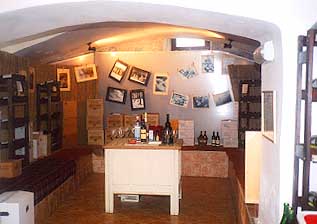
Right from the beginning, the Torres family has taken great care in seeking out and acquiring
some of the best vineyard plots. The Penedès vineyards cover a total of 1300 hectares
(3200 acres) planted with different grape varieties, both traditional and international.
The Torres family's imprint on the Spanish wine industry is impressive. Miguel Torres, Jr. is
one of the wine world's great innovators and leaders. He was named Winemaker of the
Year—Spain 2002.
One of his innovations—is that if you "age too much in oak"—wines all start tasting the same.
Miguel Torres does not follow the strict Spanish "denominations" such as in Rioja, that force
you to keep long in oak. "Wine is ready"—when Mr. Torres says it is!!
"And yes—you can taste the differences!!"
While remaining rooted in a lovingly conserved ancestral Spanish heritage, Torres today
offers the widest and most diverse range of wines on the market. In Chile, Torres has been
producing wines since the end of the 1970s, with a brother overseeing the operation. Chile is
the best land in the world for growing grapes due to its volcanic soil. Cabernet Sauvignon
and Sauvignon Blanc grapes are grown there. A sister moved to the Napa Valley area in the
1980's. Her Green Valley/Russian River winery produces wines from two grapes—Chardonnay
and Pinot Noir.
Torres wines are currently enjoyed in more than 115 countries worldwide—found on wine
lists in many of the world's finest restaurants and hotels.
Now let's
taste wines!!—
1—Santa Digna—2001 Chile White—100% Sauvignon
Blanc Grape
Clear pale yellow color. Fruity aroma with medium intensity. Dry and well balanced, this is
an easy-to-drink wine in summer. Drink it on your patio, take it on a picnic—Price
350CZK, approximately US$11.00.
2—Gran Vina Sol—2001 Spain White—85%
Chardonnay/15% Parellada Grape
The parellada, a typical grape variety grown in the Penedès region of Spain, gives this
wine an exotic fruit flavor. Color is crystal clear straw yellow. Aroma is fruity fresh with
hint of citrus and bananas. Aged three months in oak, the wine is crisp and well balanced.
Serve with fish, seafood or pasta dishes—Price 390CZK, approximately US$12.50.
3—Vina Esmeralda—2001 Spain
White—Muskat/Gewurtztraminer Grape Blend
Flower aroma denotes mostly muskat in this lovely and different wine. Color is crystal clear
green yellow. Wonderful with Asian cuisine—especially Thai and Japanese. This wine can
also be served as an aperitif—Price 360CZK, approximately US$11.50.
4—Santa Digna—2001 Chile Rosé—100%
Cabernet Sauvignon Grape
Beautiful dark pink color. Aroma is concentrated and powerful—fruity. Strawberries and
plums against a background of grapefruit. Unusual and wonderful, you don't taste the 14%
alcohol content. Balanced with delicate fruity acidity and easy-to-drink. Wonderful
aftertaste—smooth. Serve as an aperitif, or with chicken, ham or tapas—Price
320CZK, approximately US$10.00.
5—Sangre de Toro—2000 Spain Red—75%
Gamacha/25% Carinena Grape
Composed of typical Mediterranean grape varieties. Color is a rich dark ruby red. Aroma is of
medium intensity with a hint of spice. Aged for 12 months in American oak, this wine is full
bodied and balanced. Serve with steak or game—Price 300CZK, approximately
US$9.50.
6—Coronas—1999 Spain Red—15% Cabernet
Sauvignon/85%Tempranillo
The Tempranillo grape gives this wine its rich garnet color. Aged in oak for 12 months, this
elegant wine is full bodied, with balanced tannins. Serve with red meats or soft
cheeses—Price 340CZK, approximately US$10.50.
7—Atrium—2000 Spain Red—100% Merlot
Grape
The reason for the name "Atrium"—Miguel Torres wanted to give this wine a name that can
match different things—such as Atrium—being the hub of a house! Fruit is predominant in this
deep red wine with purple overtones. Aged for 6 months only in French new oak, flavor and
aroma suggest plum and cherry. This wine is so good—you can almost chew it!! A versatile
wine, serve it with fish and salmon as well as duck and cheese. Age for 2 to 4 years—it should
still be wonderful—Price 420CZK, approximately US$13.00.
8—Gran Sangre de Toro—1999 Spain Red—65%
Gamacha/25% Carinena/10%Syrah
This elegant wine was aged 18 months in American oak before release. Color is intense ruby
red. Nose suggests smoke, black pepper and fresh fruit. Taste is smooth-as-silk. Serve with
venison, stuffed peppers, stews, game and spicy meat dishes. Age for 7–9 years—it should still
be extraordinary!—Price 450CZK, approximately US$14.00.
9—Brandy 10—
We were served a special treat!! 10 years old—Torres 10 Brandy Gran Reserva. Velvety and
smooth, with caramel and some toffee on nose. The perfect after-dinner drink!!—Price
420CZK, approximately US$13.00.
Looked!—Smelled!!—Tasted!!!—Bought!!!!—Enjoying!!!!!
A note on my wine prices. The wines quoted in CZK are available here in Prague. I translated
the prices into US$ as an aid. Prices in your country can vary due to taxes, duties, etc. Check
with your favorite wine merchant. Enjoy these fine wines!!
Helena Baker, Baker Wine—hosts wine-tasting almost
weekly in her vinnysklep(wine cellar) located near the Prague Gate in Beroun. She studied
wine-tasting at the Wine & Spirit Education Trust in London, where she received the WSET
accolade—Diploma in Wines and Spirits. Find out more. Click below—
| Baker Wine |
If you don't wish to drive, there are many buses available leaving from various Prague
stations to Beroun. Pick your preferred bus and route below. When you access the schedules,
scroll down and click on the "English" icon to read in English. Be sure to enter "Praha"—not
Prague—
| Buses to Beroun |
A Short Guide to Tasting Wine—Look, Smell,
and Taste!
Look At It!
Pour the wine into a clear wine glass. Hold in front of a white background—or lighted candle.
Examine the color.
White wines are not really white—colors range from green to yellow to brown. More color in a
white wine indicates more flavor and age. A brown wine might have gone bad. Time
improves many red wines. Time ruins most white wines. Red wines vary from pale red to
deep brown red. Reds usually become lighter in color as they age.
Edge: You can guess the age of a wine by observing its "edge." Tilt the glass slightly
and look at the edge of the wine. A thicker edge usually indicates a young wine. A purple tint
may indicate youth in a red wine. An orange to brown tint is usually found in a more mature
red wine.
Swirling: Swirl and observe wine's body. "Good legs" are the droplets that form and
ease down the sides of the glass. "Good legs" indicate thicker body and higher alcohol
content—and sometimes sweetness level.
Smell It!
- Swirl your wine again. Molecules are released. Smell the aroma—also called the
"bouquet" or "nose".
- Take a quick whiff—form your initial impression. Then take a second deeper whiff.
- Sit back and contemplate the aroma. Don't try to "taste" the wine yet—just concentrate on
the smell.
Taste It!
The most important quality of wine is balance between sweetness and acidity. Get the full
taste. Follow these steps—
- Initial taste—First impression! Your senses awaken. Your taste buds
respond.
- Taste again—Slosh the wine around your mouth. Draw in some air. You may
look funny. Taste the body and texture. Is it light or rich? Is it smooth or harsh?
- The "finish" (aftertaste)—The taste remains in your mouth after the wine
is swallowed. How long did the taste last? Was it pleasant?
After tasting the wine, take a moment. Think of its overall flavor and balance. Is the taste
appropriate for that type of wine? If the wine is very dry, is it supposed to be?
Taste many different wines. Pay attention when you taste each wine. You will become
knowledgeable. You will enjoy their various characteristics.
This is difficult to describe in words when you're new at wine tasting. After many wine
tastings, you will notice similarities and differences. A certain smell may be very strong, and
have hints of other smells. Go slowly. Labeling the aroma will help you to remember it. Keep
a notebook. Save the labels. When you see the wine again, you won't have to buy it to know
if you like it—or not!
Email me:
Flight To
Quality—Quality begins here!














